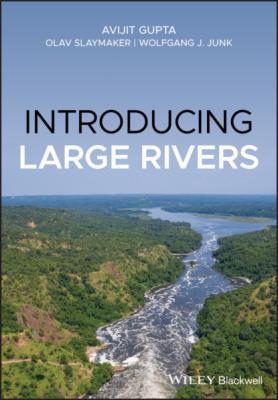ТОП просматриваемых книг сайта:
Introducing Large Rivers. Avijit Gupta
Читать онлайн.Название Introducing Large Rivers
Год выпуска 0
isbn 9781118451434
Автор произведения Avijit Gupta
Жанр География
Издательство John Wiley & Sons Limited
Completion of the book has been a demanding task and I am grateful to the editorial and production teams of John Wiley & Sons, Ltd for their remarkable patience, editorial assistance, and continuous encouragement. I would like to thank Athira Menon and Joseph Vimali for guiding me through the intricacies of book production. Lee Li Kheng has produced many of the diagrams from my rough sketches. I have tremendously benefited from the critical readings by Colin Murray-Wallace of Chapter 7 on past rivers and by Colin Woodroffe of Chapter 6 on large river deltas and a discussion on climate change with John Morrison.
Wollongong, Australia, June 2019
Avijit Gupta
Note
1 1 Gupta, A. (Ed.) (2007). Large Rivers: Geomorphology and Management. Wiley: Chichester.
1 Introduction
1.1 Large Rivers
We have an intuitive recognition of large rivers although a proper definition is elusive. Even though it is difficult to define a large river, we would probably select the same 15 or 20 rivers as the biggest in the world. Potter identified four characteristic properties of large rivers: they drain big basins; they are very long; they carry a large volume of water; and they transfer a considerable amount of sediment (Potter 1978). It is, however, difficult to attribute quantitative thresholds to these, and not all big rivers exhibit these four characteristics. We associate large rivers with high discharge and sediment transfer, but both water and sediment vary over time and space and their data are difficult to acquire. It is easier to identify large rivers by the size of their drainage basins and their lengths; both are easier to measure.
Based on the areal extent of their drainage basin, Potter (1978) examined 50 of the world's largest rivers, ranked by Inman and Nordstrom (1971), starting with the Amazon. All but one of these rivers are more than 103 km long, and the smallest drainage basin is about 105 km2. These 50 rivers collectively drain about 47% of the land mass, excluding Greenland and Antarctica. The Amazon alone drains about 5% of the continental area. These rivers also have modified the physiography of a large part of the world. Table 1.1 lists the top 24 large rivers (Figure 1.1), ranked according to their average annual water discharge. Their ranks would change if the rivers were listed according to any of the other three properties.
There are other lists. Hovius (1998) tabulated the morphometric, climatic, hydrologic, transport, and denudation data for 97 river basins, all of which measured above 2.5 × 104 km2. Meade (1996) ranked the top 25 rivers twice: first, according to their discharge; and second, according to their suspended sediment load. The two lists do not match well. For example, large rivers such as the Zambezi or Lena carry a large water discharge but a low sediment load. Impoundments too have drastically reduced the once high sediment load of many rivers such as the Mississippi-Missouri. Over approximately the last 100 years, many rivers have been modified by engineering structures such as dams and reservoirs. The Colorado or the Huanghe (Yellow River) at present may not flow to the sea round the year. Such changes have also reduced the amount of sediment that passes from the land to the coastal waters. Large rivers such as the Nile or Indus have been associated with human civilisation for thousands of years and show expected modifications.
Table 1.1 Selected characteristics of 24 large rivers.
| River | Average annual water discharge (106 m3) | Length (km) | Drainage basin area (km2) | Current average annual suspended sediment discharge (106 t) |
| 1. Amazon | 6300 | 6000 | 5.9 | 1000–1300 |
| 2. Congo | 1250 | 4370 | 3.75 | 43 |
| 3. Orinoco | 1200 | 770 | 1.1 | 150 |
| 4. Ganga-Brahmaputra | 970 | B-2900 G-2525 | 1.06 (B-0.63) | 900–1200 |
| 5. Changjiang | 900 | 6300 | 1.9 | 480 |
| 6. Yenisey | 630 | 5940 | 2.62 | 5 |
| 7. Mississippi | 530 | 6000 | 3.22 | 210 |
| 8. Lena | 510 | 4300 | 2.49 | 11 |
| 9. Mekong | 470 | 4880 | 0.79 | 150–170 |
| 10. Paranẚ-Uruguay | 470 | 3965 | 2.6 | 100 |
| 11. St. Lawrence | 450 | 3100 | 1.02 | 3 |
| 12. Irrawaddy | 430 | 2010 | 0.41 | 260 |
| 13. Ob | 400 | >5570 | 2.77 | 16 |
| 14. Amur | 325 | 4060 | 2.05 | 52 |
| 15. MacKenzie | 310 |
4200
|

